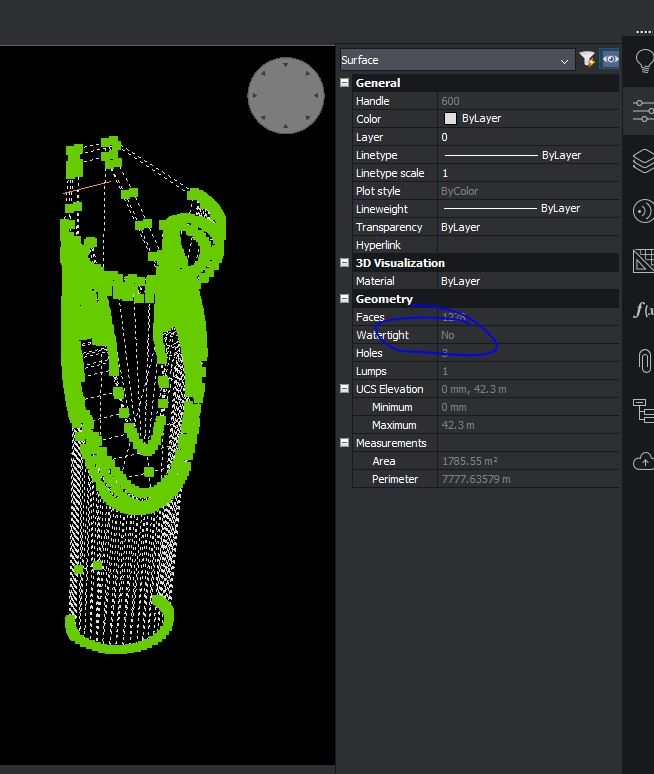Convtosolid
Hi, What workaround to convert this skp surfaces shape to a solid?
The problem is that Sketchup does not give me watertight surfaces on import.

Comments
-
I usually try again by exploding, to look for duplicated Faces
(usually brighter in OpenGL Shaded modes)
and try to select and delete until there is only a single Face.If I find a hole, I try to close it with a 3D Face.
Then the typical Regions>Stitch>Audit>Simplify orgy.
If needed start again from top until it is a Solid.At a certain point, redrawing or other alternatives may be
less time consuming.0 -
I want to avoid manual stitching a s much as possible.
Spotted some problem area's. DAE gives me meshes, this tool has no effect.nb
This sample file can be downloaded from Sketchup Warehouse here.
https://3dwarehouse.sketchup.com/model/72ff57bddc1513a480c90c65da5eb57d/Bilbao-airport-ATC-tower 0
0 -
Well,
Bricscad isn't the best App to deal with or to repair Meshes.
I am doing far easier with Vectorworks, which does some magic when
stitching Faces or converting Meshes. Like getting rid of duplicate Faces.
I think in such a case VW would fail too though.
The advice is also to better rebuild bad geometries.Sketchup geometry is a always a mess, has been in the past and normally
I refuse to accept them from clients. If I would have to I would do all clean up
work in a Mesh Modeller before importing. Modo and/or C4D here.
In this case just select all these problematic Vertices and weld them together.
You could also use Blender to repair such Meshes.On the other hand Bricscad does very well converting Meshes to Solids
in case where these are proper Meshes.
And basically Solids are only as good as the information you put into it,
Basically you don't want that Cone's Mesh tessellation in your solid
but a Loft from two true Circle Profiles with cut off at the ends.So it is not really a Bricscad problem or something solvable by a Computer
or Algorithm, without heavy special AI usage.
So I see no better workaround for now, unfortunately.0 -
"Basically you don't want that Cone's Mesh tessellation in your solid"
You are right about that.
However. We are not always supplied perfect geometry. Somethimes you just have to deal with it
So i basicly still like to be know and be able how one can make surfaces watertight.
Used DMsticth and can't find the spots. Attached the file. Here is a picture the 'Surfsculpt' function' for the general idea.
In stead of VW I will be checking Blender to make these surfaces better. 0
0 -
Blender should be able to repair and optimize such Mesh Geometries.
Not sure about how much automation and about watertight testing
but Blender is also used for 3D printing.
So also Ultimaker's free Cura(?) Software could be helpful too.0 -
Check this post on OSARCH.
It is just a pratice in conversions.
Of course, the solid to had to be way more precise.https://community.osarch.org/discussion/83/sketchup-files-geometry-conversion#latest
0 -
@Hans Lammerts said:
Check this post on OSARCH.
It is just a pratice in conversions.
Of course, the solid to had to be way more precise.https://community.osarch.org/discussion/83/sketchup-files-geometry-conversion#latest
Interesting Thread.
Wasn't aware of that Forum.And I see Yorik Van Havre from Freecad is also there.
Nearly forgot about FreeCAD. I think it is also a bit more open to Meshes.Basically CAD Volume Models and Meshes are a completely different thing
for different purposes and not very compatible. At the Borderline you find
Apps like Rhino or even more FormZ which is good in both.Vectorworks is also clearly on the CAD side with (not very deeply) integrated
Parasolid Modeling Core. Meshes, like from Furniture Libraries will also
slow VW down, but not as much as Bricscad. And it is a bit easier to go into
a Mesh Object by Group Editing Mode and filling missing Faces with 3D Polys.
Therefore I may do some little repairing inside VW.
But you will never have the control and options like a real Mesh Modeler like
Modo, C4D or Blender. Like Sub-object Modes Vertex/Edge/Face, show and
manipulate Face Normal orientation, welding, ....I saw your Model and the geometry is terrible mess.
Top and Side Faces Ends do not meet at the Edges by 6 mm and I do not
really get the way in which it is tessellated for roundings.So with Blender you should be able to repair such Meshes if necessary.
Then Bricscad converts to Solids.
In some cases it might be worth to rebuild though.
But if it is suitable for your purpose, that's is ok.0 -
What i do not quite understand is that BricsCAD incorporates skp in Shape.
But you can't really do anything with it because the imported meshes are really incompatible with focussed solid / bim tech in BricsCAD.
So what's the point of importing skp files? I still need to do a Blender preprocessing.. Why not bring IFC in Shape and skipp skp?0 -
I think it is because ....
- large libraries of Google Warehouse
- Sketchup very popular
- Sketchup a competitor, therefore compatibility
- No IFC in Shape to not cannibalize Bricscad
Would be interesting to see if Shape was able to pull over any Sketchup users.
Or how many new users found Shape. Sometimes I think the majority of Shape
users are users that already have a Bricscad License and just play with Shape.
Would be pity.
But if Shape would not destroy BIM when saving, maybe two thirds of office
computers would run Shape (?)0 -
IMO trying to convert such crab to ACIS geometry is just a waste of resources. If you need to work on stuff like this, you will have to re-model it, there are no corners you can cut.
Still, handling of mesh geometry needs to improve substantially in BricsCAD, so that conversion from meshes to solids can be avoided as far as possible.0


